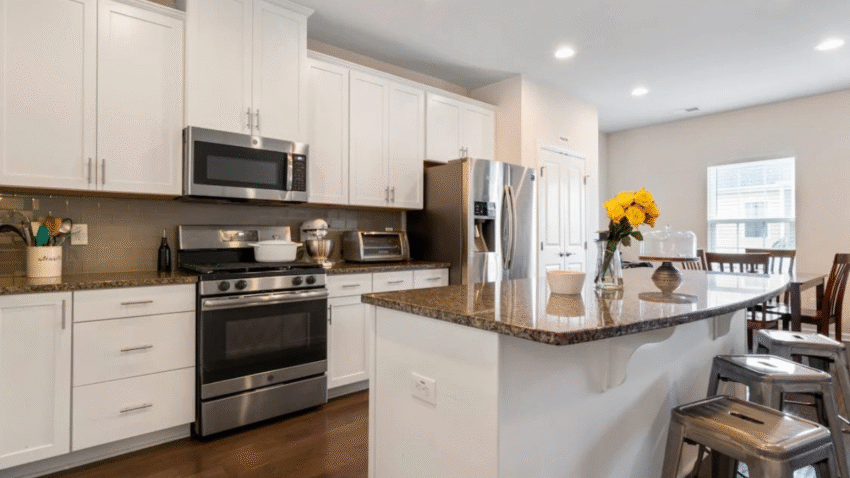Introduction
Tired of sticky surfaces and stubborn residue that won’t budge? Learning how to deal with kitchen grease safely is essential for maintaining a clean, hygienic, and fire-safe cooking space. Grease builds up on stovetops, cabinets, walls, and even your appliances—and if left unchecked, it not only looks bad but can also become a safety hazard. In this step-by-step guide, you’ll discover the best ways to remove, manage, and prevent grease buildup while protecting your kitchen and your health.
Why Dealing With Kitchen Grease Matters
Grease is more than just a mess—it’s a slippery, sticky fire hazard. It clings to surfaces, traps dust, and creates a breeding ground for bacteria. Over time, layers of grease can also damage your cabinetry, vents, and appliances.
Here’s why dealing with kitchen grease is crucial:
- Fire Safety: Built-up grease, especially near the stovetop or in range hoods, is highly flammable.
- Cleanliness: Grease attracts dust, dirt, and pests, making your kitchen appear unclean and unhealthy.
- Efficiency: Greasy surfaces reduce airflow in vents and lower the performance of fans and appliances.
- Long-Term Maintenance: Regular cleaning prevents long-term stains, odors, and damage to surfaces.
Managing grease safely is one of the most important kitchen maintenance habits you can build.
Step-by-Step Guide to Dealing With Kitchen Grease Safely
1. Identify Where Grease Buildup Happens
Before you clean, identify common grease-prone areas:
- Stovetop and surrounding backsplash
- Range hood filters and vents
- Cabinet fronts and handles
- Microwave exterior and underneath
- Countertops near cooking zones
- Floor area in front of the stove
Kitchen Tip: Shine a flashlight across surfaces at an angle to spot greasy residue more easily.
2. Use the Right Cleaning Solution
Different levels of grease require different cleaning agents:
- Light grease: Use warm soapy water (dish soap cuts grease well).
- Moderate buildup: Mix equal parts vinegar and water in a spray bottle.
- Heavy buildup: Create a paste with baking soda and water or use a degreasing cleaner specifically designed for kitchens.
Reminder: Avoid using abrasive sponges on delicate surfaces like stainless steel or painted cabinets—use microfiber cloths or soft-bristled brushes instead.
3. Clean Step-by-Step
Here’s a safe and effective grease-cleaning process:
- Prep the Area: Turn off nearby appliances. Lay a towel or newspaper to catch drips.
- Spray the Solution: Apply your chosen cleaner to the greasy area. Let it sit for 3–5 minutes to loosen buildup.
- Scrub Gently: Use a non-scratch scrub pad or microfiber cloth to scrub in circular motions.
- Rinse & Wipe: Wipe away the grease and cleaner using a damp cloth.
- Dry Completely: Use a clean dry towel to remove moisture and prevent streaks.
Kitchen Hack: For vent filters, soak them in hot water with a degreasing dish soap for 20 minutes, then scrub with a brush and rinse clean.
4. Dispose of Grease Properly
Never pour grease down the sink—it can clog pipes and cause sewer backups. Instead:
- Let it cool: Pour cooled grease into a disposable container (like an old jar).
- Wipe before washing: Use paper towels to wipe out greasy pans before rinsing.
- Throw it away: Seal and dispose of the grease container in the trash once full.
Pro Tip: Use a designated “grease jar” in your kitchen for convenience and eco-friendliness.
5. Take Preventative Steps
Prevent grease buildup before it becomes a problem:
- Use splatter guards or lids when frying.
- Wipe down surfaces daily, especially after cooking oily meals.
- Clean your range hood filter every month.
- Place a grease-catching mat under your stove or near your fryers.
- Install a backsplash with easy-to-clean material like glass or tile.
Common Mistakes to Avoid
Mistake 1: Using Harsh Chemicals on the Wrong Surfaces
Solution: Always check that your cleaner is safe for your countertops, appliances, and cabinetry. Vinegar, for instance, should not be used on natural stone.
Mistake 2: Letting Grease Sit Too Long
Solution: Clean spills and splatters immediately after cooking. The longer grease sits, the harder it is to remove.
Mistake 3: Pouring Grease Down the Drain
Solution: Pour grease into a container, let it harden, and dispose of it in the trash to avoid clogged pipes.
Mistake 4: Using One Cloth for Everything
Solution: Use separate cloths for greasy surfaces and food-prep zones to avoid spreading residue or bacteria.
Mistake 5: Forgetting About Hidden Spots
Solution: Don’t neglect areas like the top of your fridge, under the microwave, or range hood filters—these often get greasy over time.
Extra Tips & Kitchen Hacks
Tip 1: Steam First for Easier Cleaning
Before scrubbing thick grease, boil water in a pot on the stove to create steam. This softens grime on surrounding surfaces and makes wiping easier.
Tip 2: Use Lemon Oil as a Natural Degreaser
After cleaning, rub a few drops of lemon essential oil on your stovetop or cabinet surfaces. It cuts grease and leaves a fresh scent.
Tip 3: Switch to Grease-Fighting Dish Soap
Choose a dish soap with a proven grease-cutting formula and keep it in a labeled spray bottle for quick cleanups around the kitchen.
Related Task: See our full guide on how to prevent mold growth in the kitchen to keep your entire space clean and safe.
Conclusion
Kitchen grease is unavoidable—but manageable. With the right cleaners, consistent habits, and safe disposal methods, you can keep your cooking space clean, safe, and looking great. Tackle grease as part of your regular kitchen routine to prevent buildup, protect your appliances, and ensure food safety.
Bookmark this guide and use it to build a low-effort, high-impact grease-fighting routine in your kitchen.
